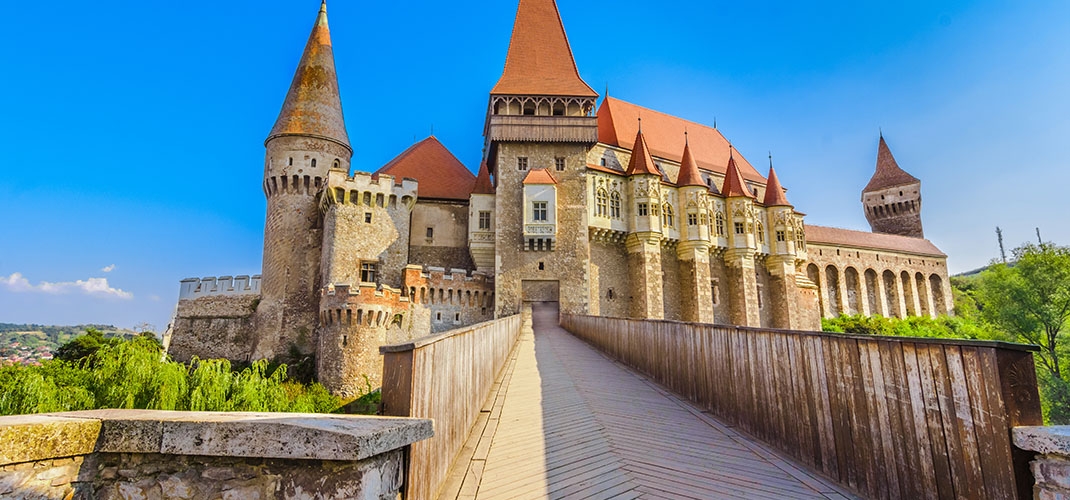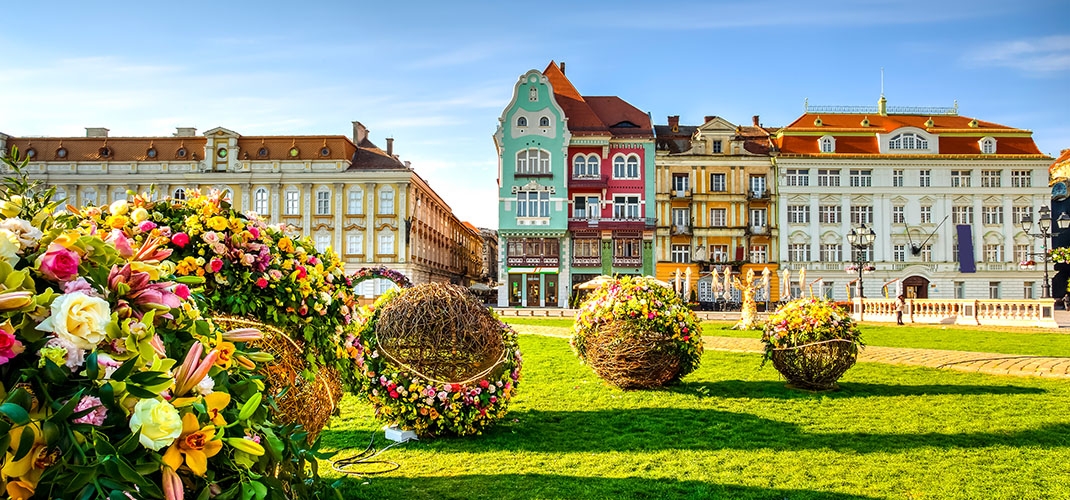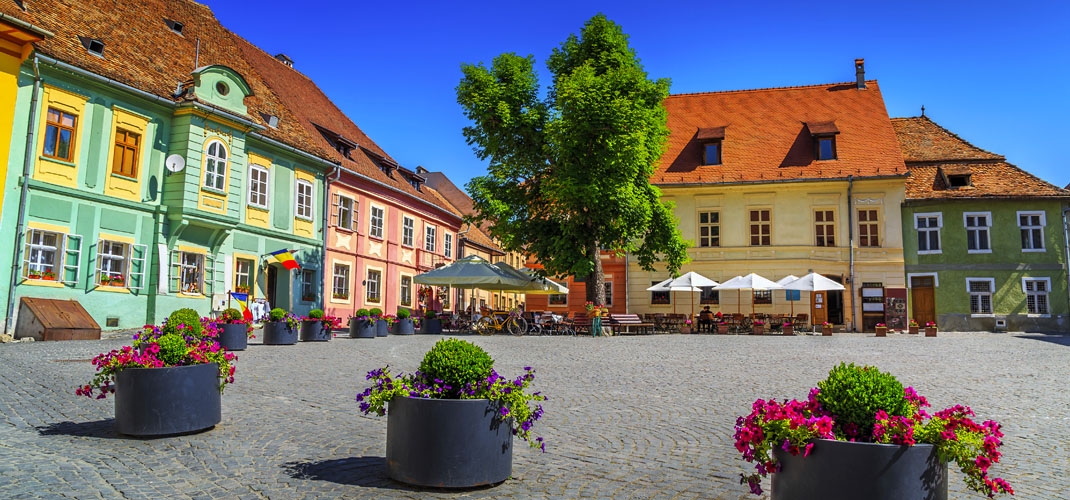Bucharest

Romania's Capital of Bucharest has a rich and storied history that merges with its modern personality. Once known as ‘Little Paris’ for its elegant architecture, Bucharest’s charm is in its sprawling city parks, museums and the charming alleyways of the Old Town. A stroll down Calea Victoriei is arguably one of the prettiest places to visit in the city.
The 15th-16th Century Old Town is one of Bucharest's earliest settlements. Over the centuries, it has been the seat of Romanian Princes, a centre for trade and a place to worship. It has also managed to survive Ceausescu's 1980’s razing of one fifth of the city to build his vision of a new Socialist capital. A lot of the Old Town has been renovated since the fall of communism and popular places to visit include the Curtea Veche, an open-air museum built on the site of the Old Princely Court, once home to Vlad the Impaler and the National Museum of Romanian History with its fine collections of religious and Royal treasures.
The Palatul Parlamentului (Palace of the Parliament) is a must visit site and is the world's second largest administrative building after the Pentagon, an architectural giant that also claims title as the heaviest building in the world. Featuring more than 3,000 rooms over 330,000 square metres and constructed with marble and steel, it was originally called the People's House by its visionary, the dictator Nicolae Ceausescu, who used it as his family's residence and as well as the seat for his Government.
Home to the George Enescu Philharmonic Orchestra, the stately Ateneul Român (Romanian Athenaeum) is the city's most famed Concert Hall. This 19th Century building resembles an ancient Greek Temple with a 41 metre high dome and a peristyle of six Ionic columns. The lobby incorporates intricately painted gold leaf ceilings, cascading balconies and spiral marbled staircases.
In 1724 the tiny Manastirea Stavropoleos (Stavropoleos Church) was built by a Greek monk, Ioanikie Stratonikeas. With its intricately carved entrance lined with columns, this Brâncovenesc style Church stands apart as a unique landmark in Bucharest with fine stone and wood carvings, frescoes and a combination of Romanian and Byzantine elements. It is surrounded by a garden courtyard filled with 18th Century tombstones.
Located in the heart of the Old City, the Curtea Veche (Old Princely Court) was the Palatial Residence of Wallachian Princes. Perhaps its best known occupant was Vlad Tepes, otherwise known as Vlad the Impaler, who inspired Bram Stoker's tale of Dracula. A statue of the infamous Romanian Prince stands among what's left from the past, including the court's walls, several arches and columns. Mircea Ciobanul, a 16th Century Prince repaired the Palace after Vlad the Impaler's rule and he grew the surrounding Lipscani area as the trading core of Bucharest by establishing a community of skilled craftsmen. In 1559, Ciobanul built the Old Princely Court Church next to the Palace.
Piata Revolutiei (Revolution Square) earned its name after setting the scene of dictator Nicolae Ceausescu's final minutes of power in Romania. On December 21, 1989, a coup d'état ensued here with the help of a crowd of more than 100,000, forcing the leader of the communist party to flee and changing the course of the country's history. Until that date, the square was known as Palace Square, due to its proximity to the Royal Palace, which is the current home to the National Museum of Art.
Bucharest's first Arcul de Triumf (Arch of Triumph) was finished in 1878, made from wood and dedicated to the Romanian soldiers who fought in World War I. In 1936, it was reconstructed in granite at a height of 27 metres. The arch is adorned with sculptures created by the most notable Romanian sculptors. Today is continues to serve its goal of being the central point for military parades including every 1st December, which is the country's national holiday.
Following King Michael I abdication after World War II, the Neoclassical Royal Palace on Revolution Square became the headquarters of Romania’s Muzeul National de Arta al României (National Museum of Art). The Museum houses collections dating back to the 15th Century including European Art, Romanian Medieval Art and Modern Romanian Art from celebrated artists including Theodor Aman, Nicolae Grigorescu and Gheorghe Tattarescu.
The Muzeul National de Istorie a României (National Museum of Romanian History) is situated in an attractive Neoclassical building originally built for the Romanian postal service. The largest permanent exhibit is a huge replica of the 2nd Century Trajan's Column, built in honour of the conquering Roman Emperor Trajan, who defeated Romania's ancient Dacian tribes. Thousands of gold items and Neolithic artefacts, including jewellery dating back to the Geto-Dacians, can be found in the Romanian Treasury. Amongst the permanent exhibits you will find the Romanian Crown Jewels including exquisite emerald pieces made for Queen Marie, who was the wife of Romanian King Ferdinand.
Bucharest is surrounded by beautiful parks including the oldest mid-19th Century, Cismigiu Gardens. Other parks worth exploring including the 400 acre King Michael I Park, home to the Dimitrie Gusti National Village Museum, the Carol Park considered one of the most beautiful parks in the capital and home to Romania's Tomb of the Unknown Soldier. The 1860 Gradina Botanica din București (Bucharest Botanical Garden) is spread across 17 hectares and features more than 10,000 different species of plants is also worth a visit.
The Romanian Patriarchal Cathedral was founded by the Prince of Wallachia, Constantin Șerban in the 1650’s. There have been many restorations in the 18th, 19th and 20th Centuries and unfortunately not much of the original remains. The current design is based on Curtea de Argeș Cathedral in the centre of the country. The Church holds the relics of the 13th Century Saint Dimitrie Basarabov, the Patron Saint of Bucharest. His remains are kept in a silver reliquary under a glass top panel.
Not far from the Herăstrău Park in the plush Primăverii neighbourhood, a compelling piece of 20th Century Romanian history. The Palatul Primăverii was the flamboyant residence for the notorious dictator Nicolae Ceausescu. This 80 room Palace was built in the 1960’s and includes a winter garden, wine cellar, silk wallpaper, valuable art, bathrooms with solid gold fittings and even a cinema.





